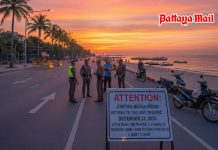
Competing to produce Second Series Banknotes – Part 2
The Siamese Minister in London, His Excellency Phya Visutr Kosa, informed Thomas de La Rue & Company, Ltd. (TdlR) in a letter dated 10th June 1907 “His Excellency Phya Suriyanuwatr, Minister of Finance, that it has been initiated that it was the intention of His Siamese Majesty`s Government that future consignments of Currency Notes shall be ordered from your firm through the Legation in London and His Excellency has requested me to place myself in communication with you with the object of concerting measures whereby I shall be in the position to satisfy myself that the watermark and printing of such future consignments are up to the standard required by the Government.”
Prior to this the Ministry of Finance in Bangkok had done the approval. From this time the Minister in London would do the approval of paper and Currency Banknotes except new designs. One of the reasons for this arrangement was that it was, at the time, very time consuming to send paper and banknotes to Bangkok for approval prior to printing.
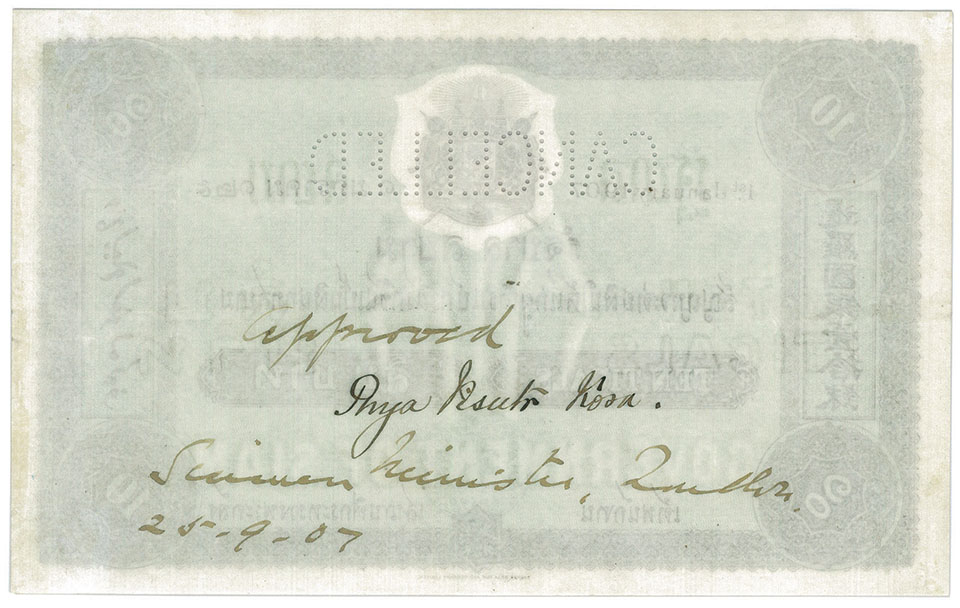
The first approval done by the Minister in London according to the archives of TdlR was for the paper to be used for the printing of 10 Tical/Baht banknotes. Three of the papers had been sent to the Minister in London on the 20th of August 1907 and one of the papers was returned to TdlR on the 4th of September duly approved. One of the papers was kept by the Minister in London for reference and one was sent to the Ministry of Finance in Bangkok.
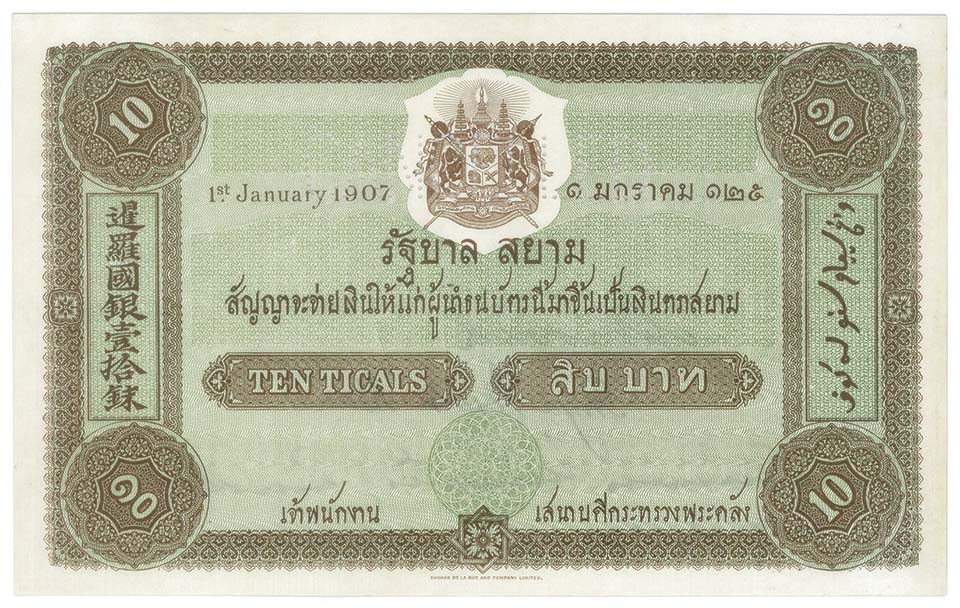
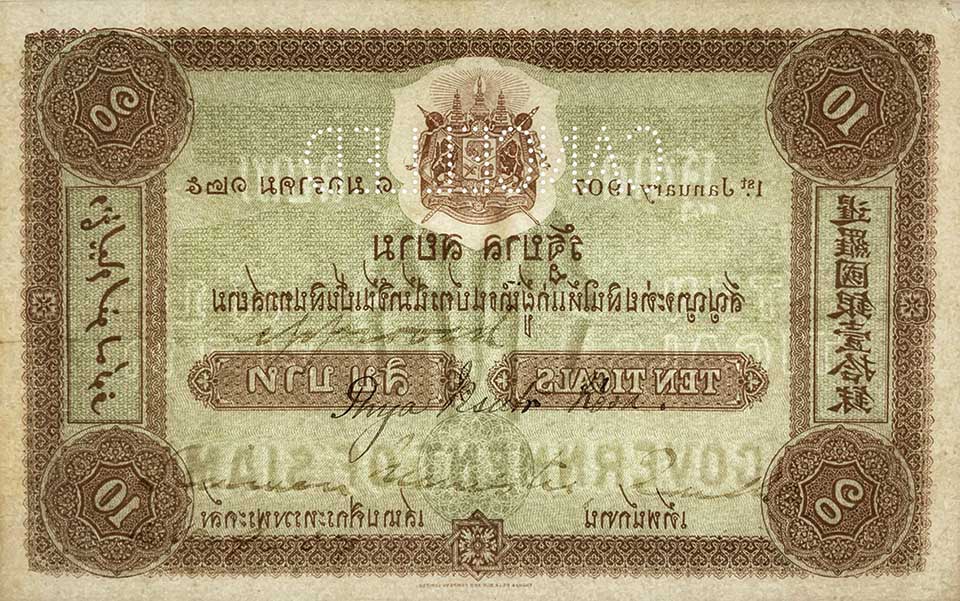
The first banknote the Legation in London approved was the 10 Tical/Baht dated 1st January 1907. The Siamese Minister in London, His Excellency Phya Visutr Kosa approved this in London on the 25th September 1907. This was printed on paper with double outline and is the last banknote approved using double outline, and the only banknote approved with double outline by a Siamese Minister in London. All the other banknotes in the First Series approved by Ministers in London were printed on paper with single outline.

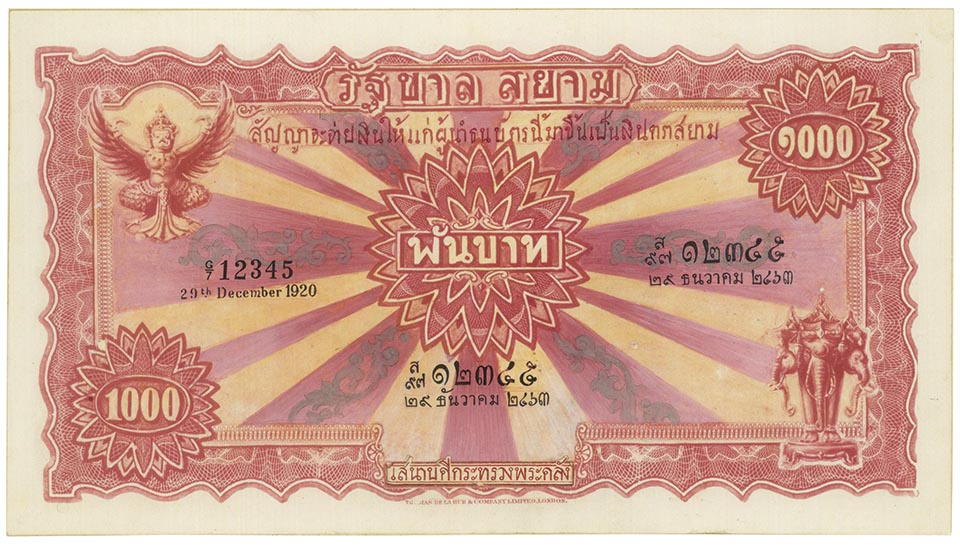
1924 Approval in Bangkok Type I
For the Second Series the approval of the new designs took place in Bangkok by the Minister of Finance, His Highness Prince Subhayok Kasem. In a letter dated 30th October 1924 from the Ministry of Finance to TdlR, the Minister informed that he approved all values based on photographic prints sent by TdlR on the 17th of September. In these prints the floral work, which had been discussed at several occasions, was now incorporated into six of the 12 rays. There was some spelling mistake in the designations. When these mistakes were corrected the proofs, specimen banknotes, were to be submitted to the Minister in London for approval. When returned to TdlR as approved, the printing could proceed.
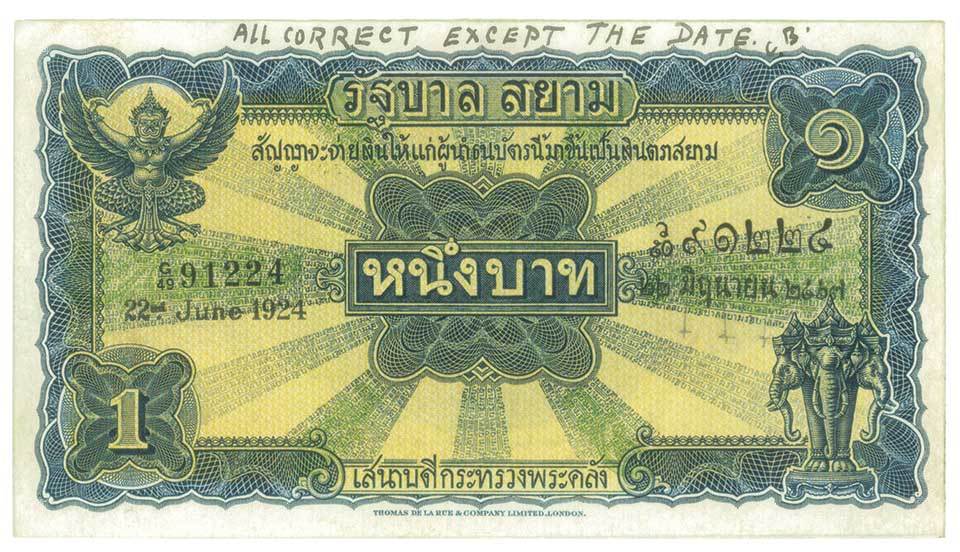
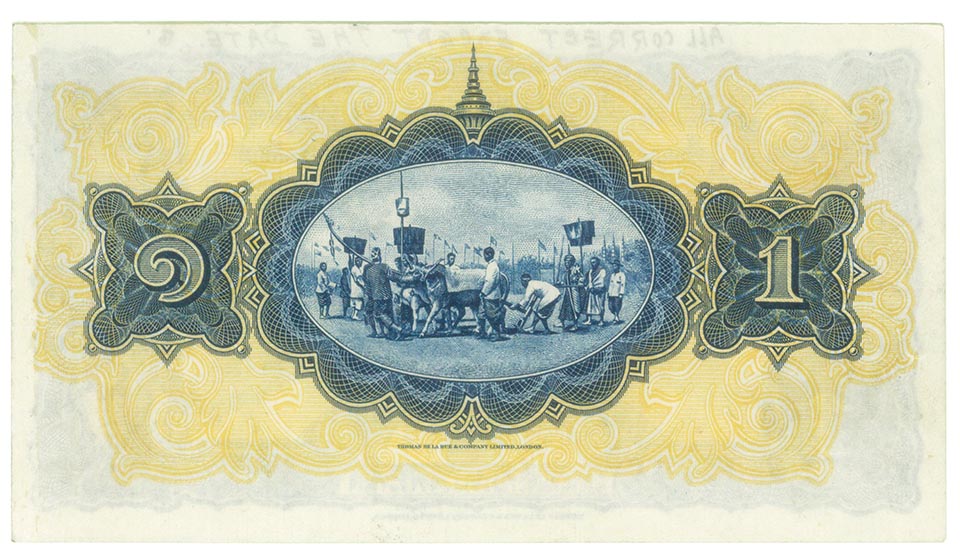
1924 Approval by Specimen Banknotes In London
The 1 Baht was the first to be approved as a finished specimen note on the 10th of November 1924. It was noted on the banknote “ALL CORRECT EXCEPT THE DATE” and initialled. Phya Prabha Karavongse, the Siamese Minister to the United Kingdom had some experience with banknotes as he had been the Minister of Siam to the United States from 1913 until 1921 when Joseph E. Ralph, former Director of the US Bureau of Engraving and Printing tried to get a contract for printing the 1 Tical/Baht First Series in 1917.
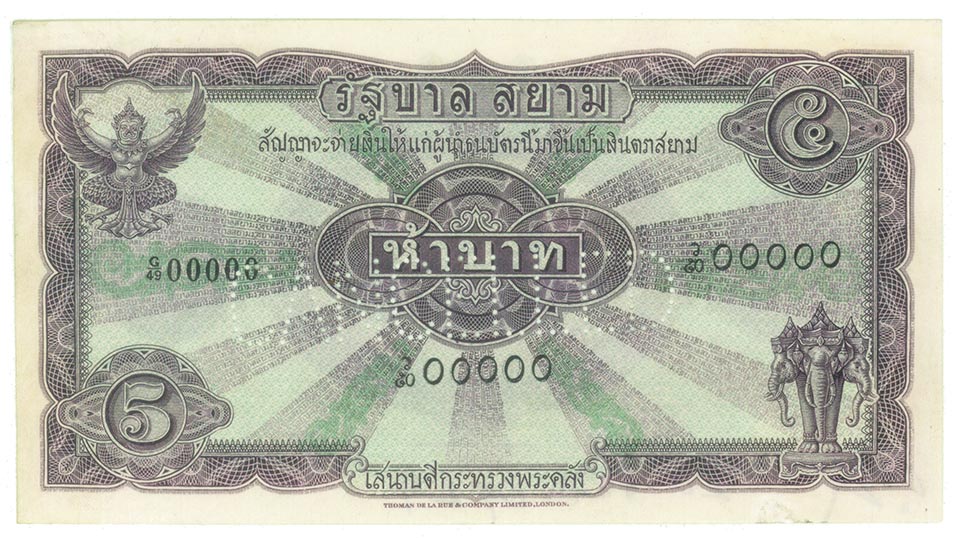
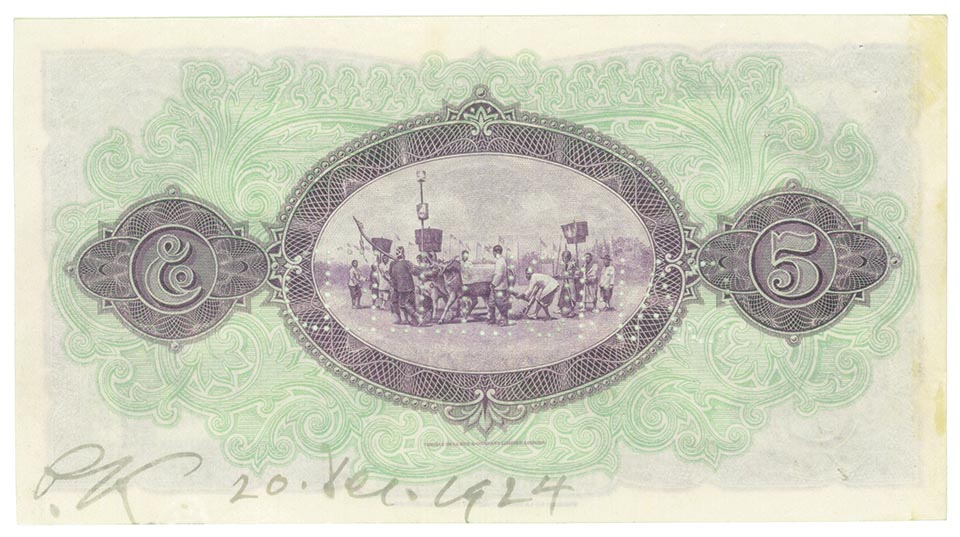
The finished design for the 5 Baht (1925) was handed to the Siamese Legation on the 19th of December 1924. The specimen banknote had the prefix G/49, number 00000 and was perforated “CANCELLED”. The Siamese Minister in London Phya Prabha Karavongse initialed “P.K” on the back of the banknote as approved with the date “20.Dec.1924”. It was returned to TdlR on the same day.
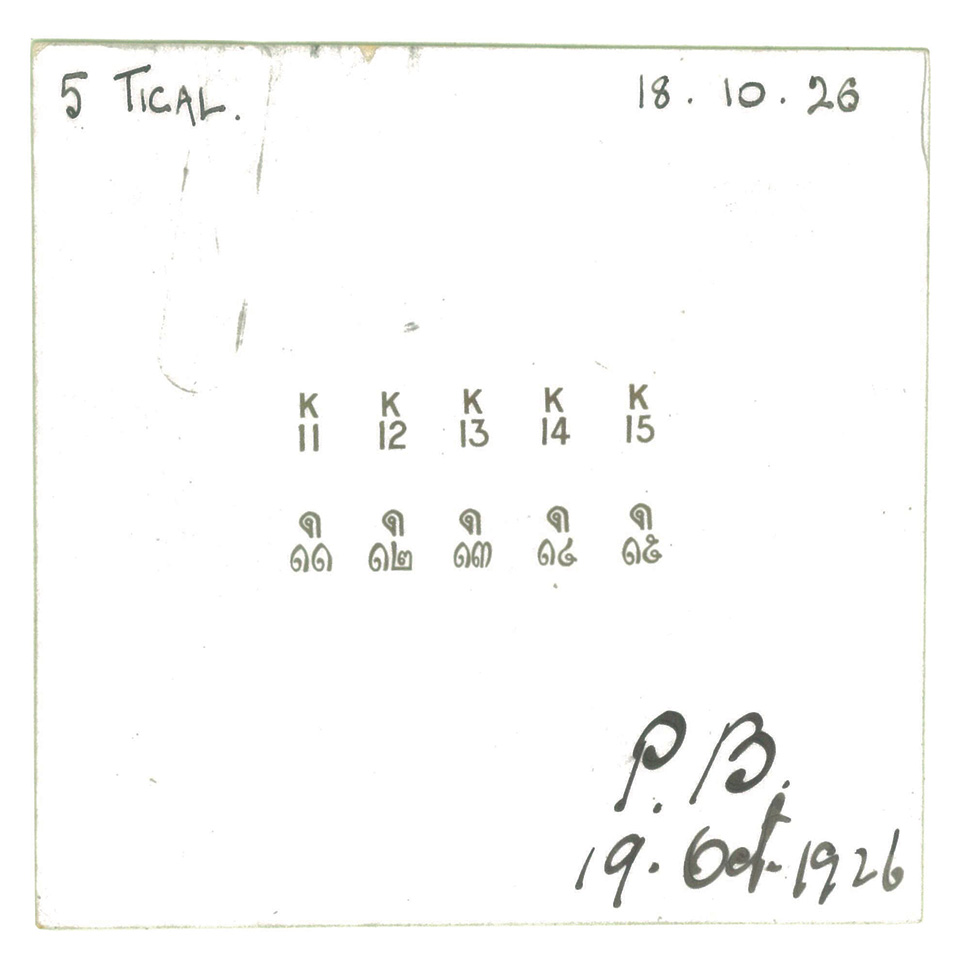
The prefixes on the specimen banknotes were often different from the circulating banknotes. On the specimen banknotes the prefixes and the numbers were added to show where they should be printed on the circulation banknotes. The Siamese Minister in London also had to approve the prefixes which were to be printed on the circulation banknotes in both English and Thai.
Delay In Submission of Approval
The Siamese Minister in London states in a letter of 30th December 1924: “I shall be glad to have your assurance that there will be no further delay in the submission for approval of the Notes of the remaining four denominations in question; especially of the Ten Tical Notes of which 200,000 will be required for the delivery in the first month”. It is interesting to notice that the Minister in London used the denomination Tical as was used along with Baht on the First Series. For the second series only the denomination Baht was printed on the banknotes. In the correspondence TdlR also used the denomination Tical.
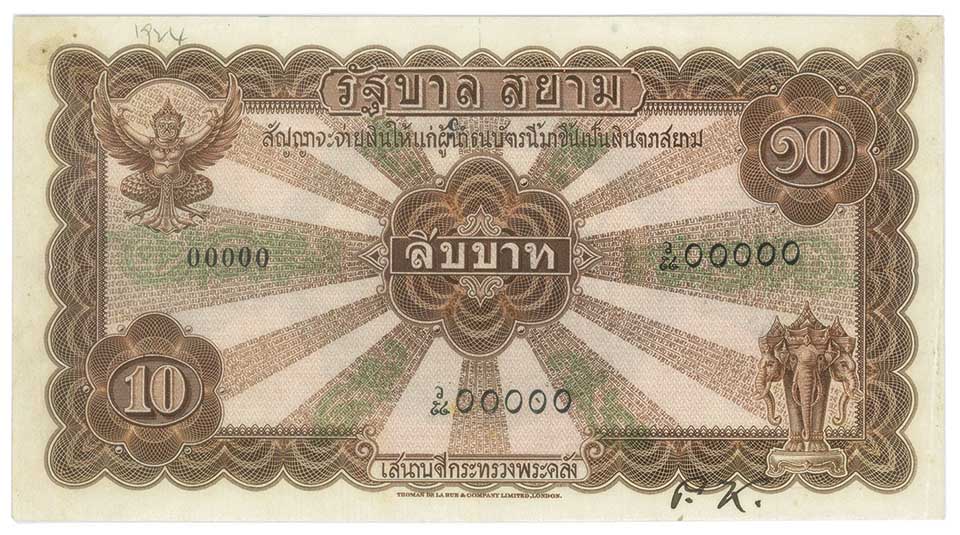

The 10 Baht was submitted for approval on the 7th of January 1925. It had the number 00000, in Thai and had the prefix V/54 and number 00000. In upper left margin it had 1924 written with pencil. The Minister in London, Phya Prabha Karavongse, initialed the banknote on the front lover margin as approved the next day.
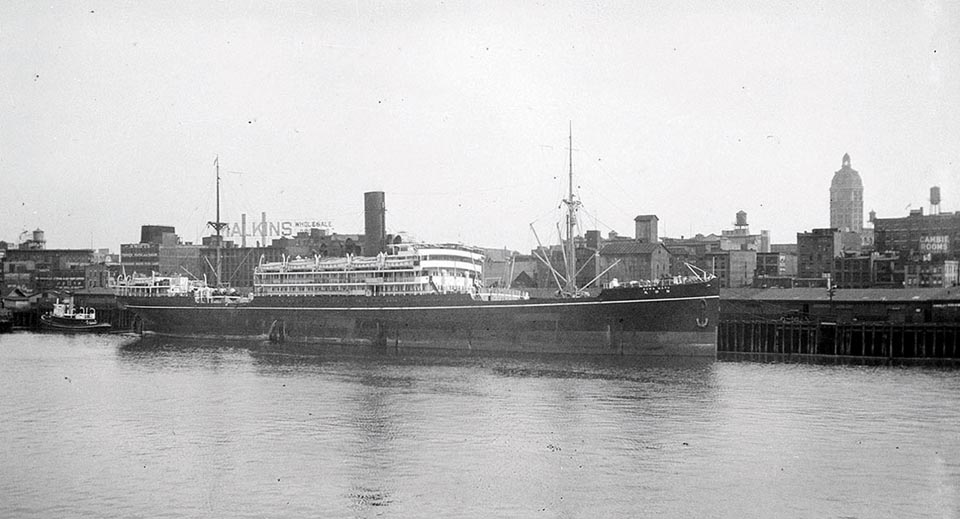
First Shipment Second Series
The first shipment of the Second Series banknotes included 800,000 pcs of the 1 Baht and 200,000 pcs of the 10 Baht. They were to be ready for dispatch on the 7th of February 1925. The first shipment was shipped with S.S. “Suwa Maru”, a Japanese Ocean Liner. The shipment was invoiced at 2,338 pounds, 14 shillings and 1 penny, which included the original plates for the two values. On the 10th of June, the Minister in London informed TdlR that “the 200,000 10 Baht banknotes were useless because they were badly cut; some had a large margin on one side and some had a large margin on the other side, with corresponding narrow edge, which made it impossible to print the signature on the same position on the notes. The Minister of Finance rejected the 200,000 10 Baht notes. TdlR agreed on the 28th of August that the badly cut banknotes would be destroyed and replaced. On the 24th of November, the Minister of Finance was informed that a new batch of 200,000 pcs of the 10 Baht notes were on the way and had been numbered with the same numbers as those to be destroyed.
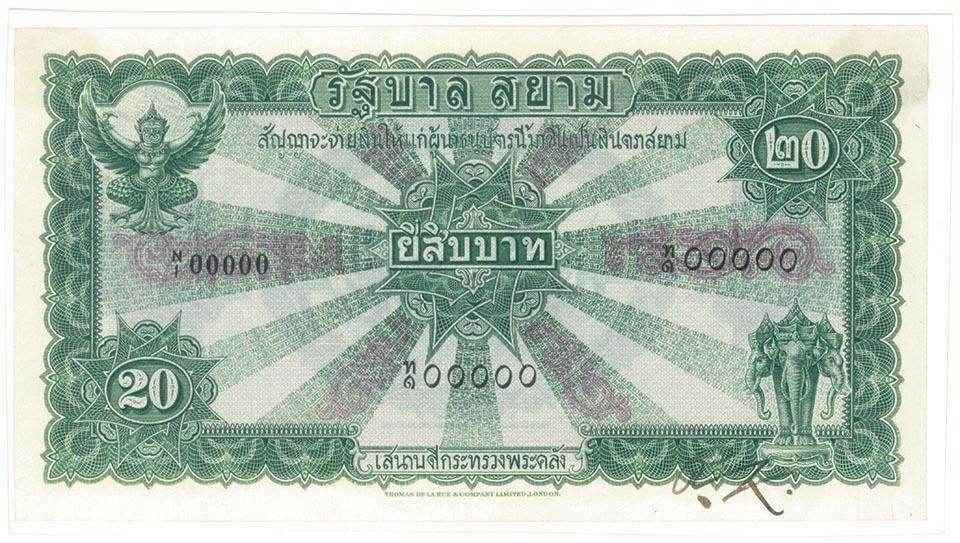
A representative of TdlR submitted 3 proofs of the 20 Baht to the Siamese Legation in London on the 12th of February 1925. One of the proofs, specimen notes was initialled by the Siamese Minister to the United Kingdom Phya Prabha Karavongse as approved and returned to TdlR a couple of days later.

The prefixes on the specimen banknotes were often different from the circulating banknotes. On the specimen banknotes the prefixes and the numbers were added to show where they should be printed on the circulation banknotes. The Siamese Minister in London also had to approve the prefixes which were to be printed on the circulation banknotes in both English and Thai.

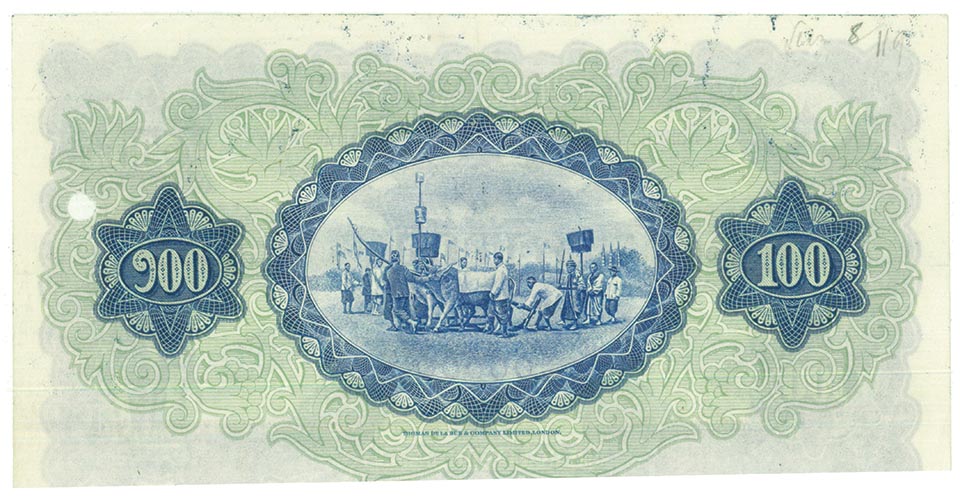
TdlR sent duplicates of the proof, specimen 100 Tical/Baht to the Siamese Legation for approval on the 14th of April 1925. One 100 Baht proof, specimen, was forwarded to the Minister of Finance in Bangkok. On the 20th of June 1925 the Siamese Legation in London informed TdlR: “His Highness (The Minister of Finance) considered the sage green tint and the colour of the border as satisfactory and better than before, so that the printing can be proceeded with”.
His Highness remarked that the proofs, specimen banknotes received had the serial lettering “N”, but understood this was only to show the position, and that the correct lettering for the circulating banknotes would have the serial numbering “S”.
1925 Secret Marks
In the letter dated 19th December 1923, the Minister of Finance H.H. Prince Subhayok Kasem had brought up the introduction of three secret marks in the plate of the new banknotes. This was not included in the contract, but had been discussed in one of the meetings with Mr. Westall of TdlR together with the Financial Advisor and the Comptroller-General of the Ministry of Finance. Mr. Westall undertook to introduce three such marks on each note, and to furnish copies to H.H. Prince Subhayok Kasem, Minister of Finance, with the marks clearly indicated and explained. Three copies would be forwarded to the Minister by registered post. The secret marks were very important as the Second Series banknotes were to be printed on paper with no watermark. The watermark on the First Series was important, making it difficult for forgers to produce fake banknotes.

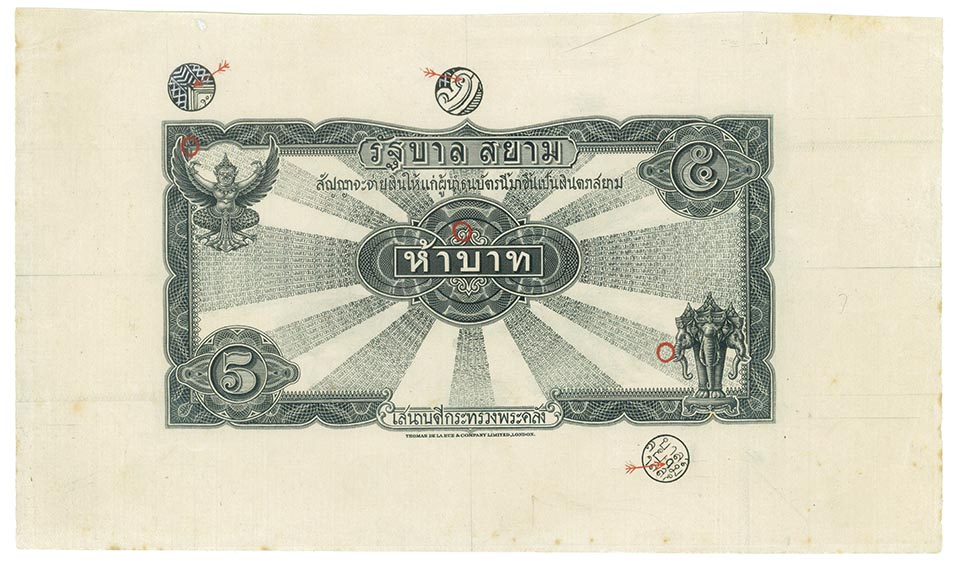
In several cases TdlR provided the secret marks in the plates after the banknotes were printed for circulation. The secret marks were on the banknotes produced for circulation, but the Ministry of Finance had not received any information as to where to find them. This could therefore be a problem to detect forgeries, as this was the main security feature to detect counterfeits on the Second Series. On the 1 baht note, the secret marks were to be found in the design. On the 5 Baht, two of the secret marks were in the design and was also in the lettering on the rays.
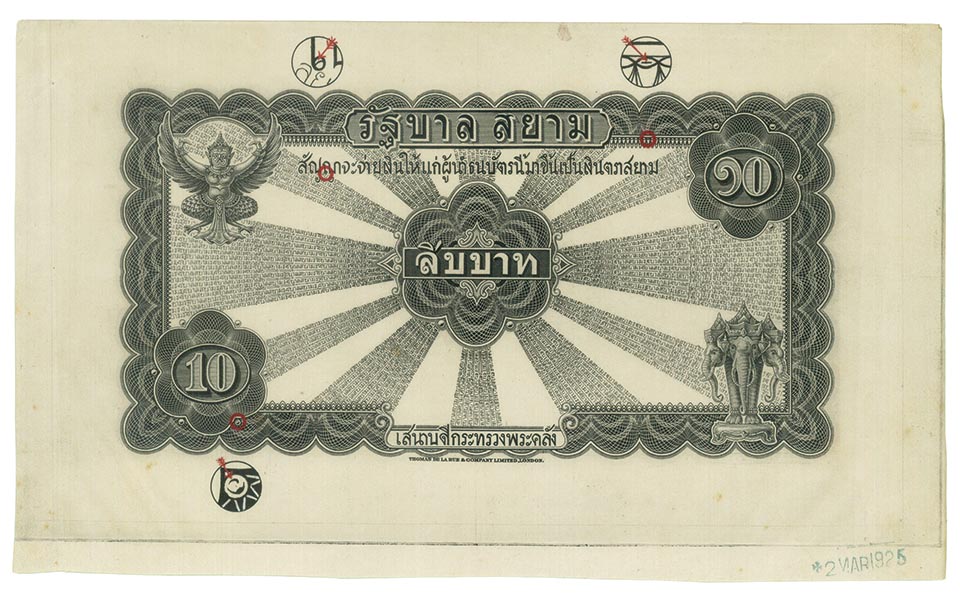
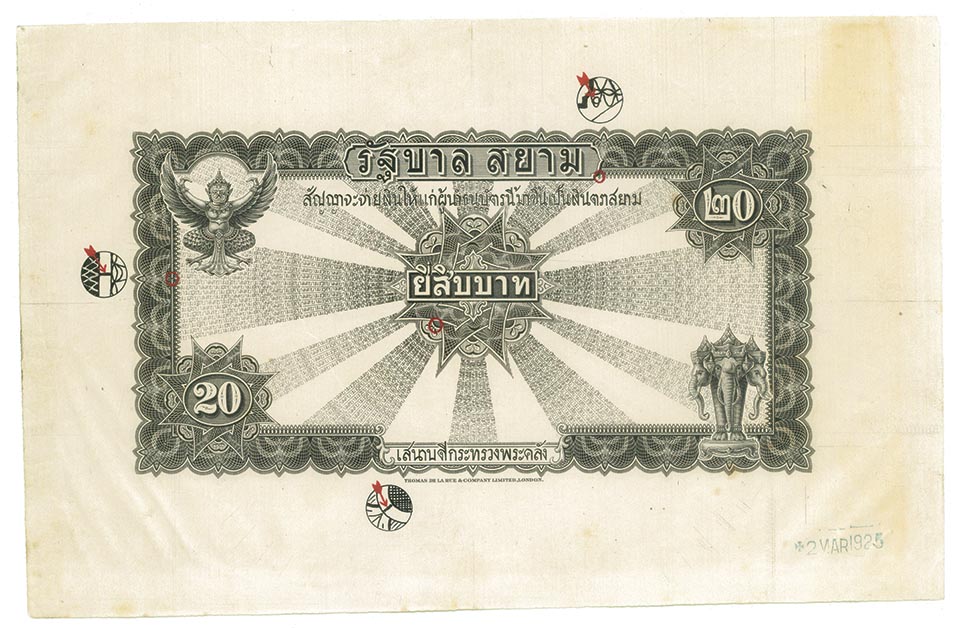
On the 2nd of March 1925, TdlR sent a duplicate 10- and 20 Baht showing the secret marks in the plates to His Excellency the Siamese Minister in London. Each of the banknotes had three secret marks in the designs or letters. The secret marks were obviously confidential as it was very important that the general public did not know them.
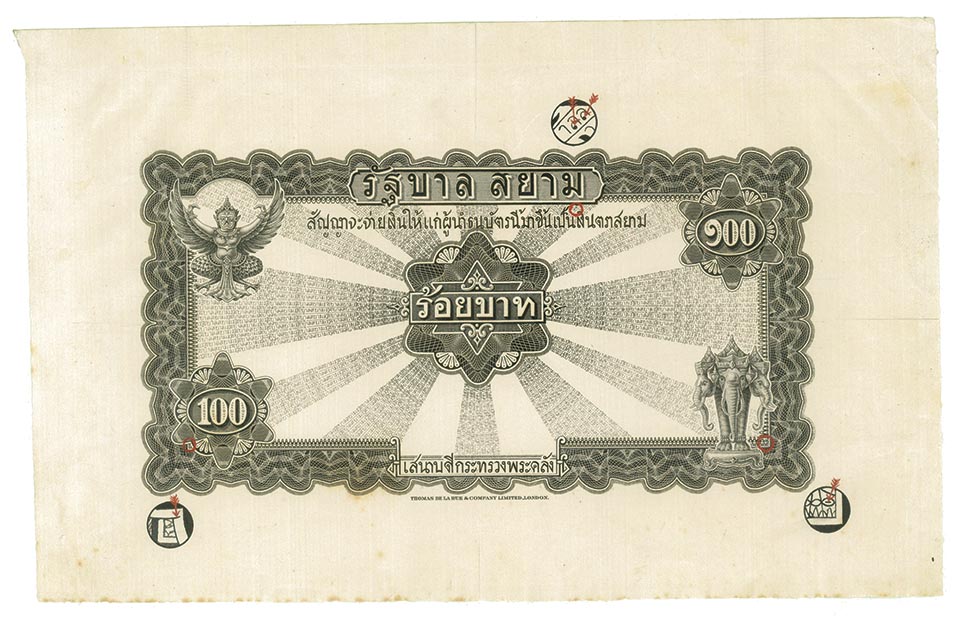
The 100 Baht with the three secret marks in the plate were sent from TdlR to the Minister of Finance in Bangkok on the 16th of April 1932, marked as PRIVATE & CONFIDENTIAL. Two of the secret marks were in the design while was in one of the letters.
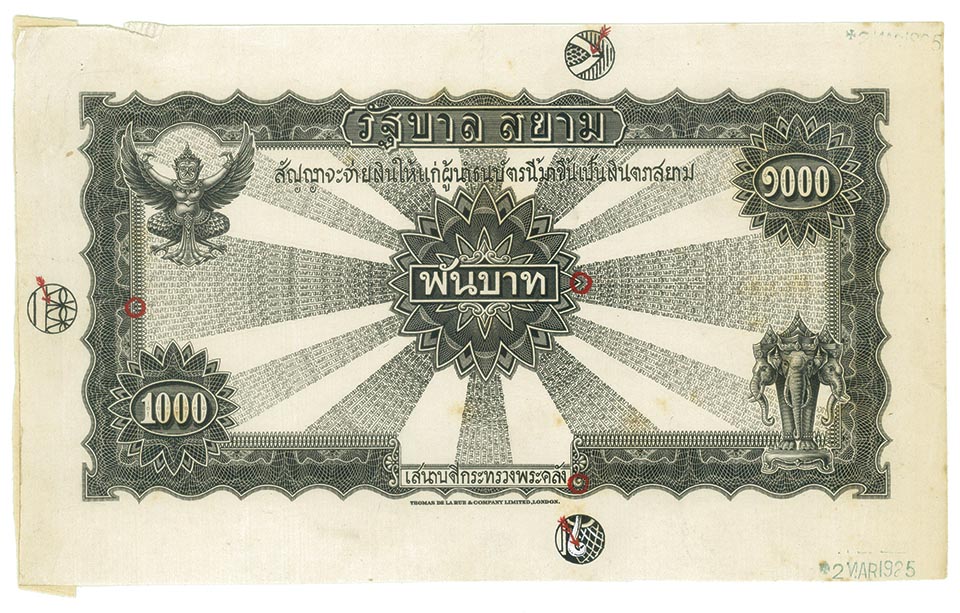
On the 2nd of June 1925 the Minister in London informed TdlR that the Minister of Finance in Bangkok requested TdlR to supply specimens of the 100- and 1000 Baht Currency Notes showing the secret marks in the plate. The 100 Baht had been sent on the 16th of April, but there could have been some delay in the post. The 1000 Baht printed from the main front plate showing the secret marks in the plate were sent both to the Siamese Minister in London and the Minister of Finance on the 9th of June 1925. On the 1000 Baht banknote the three secret marks were only in the design.
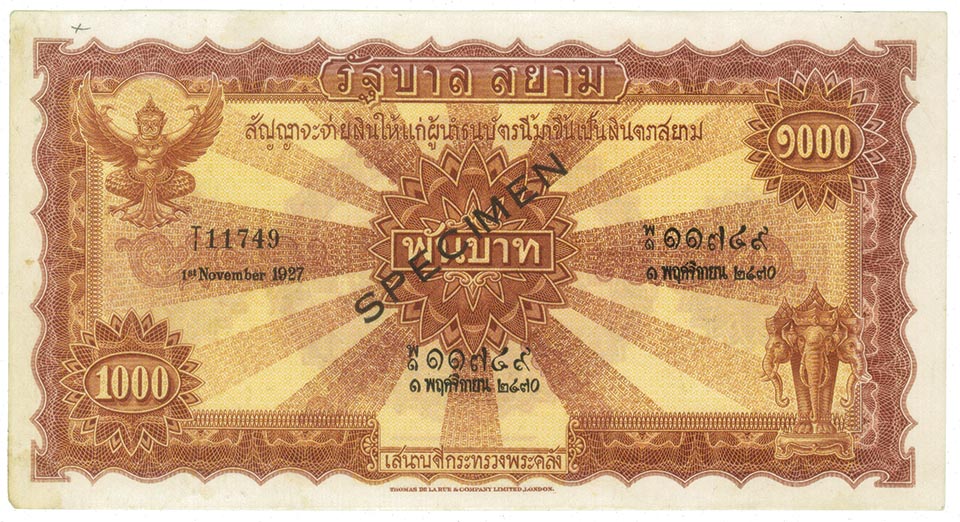
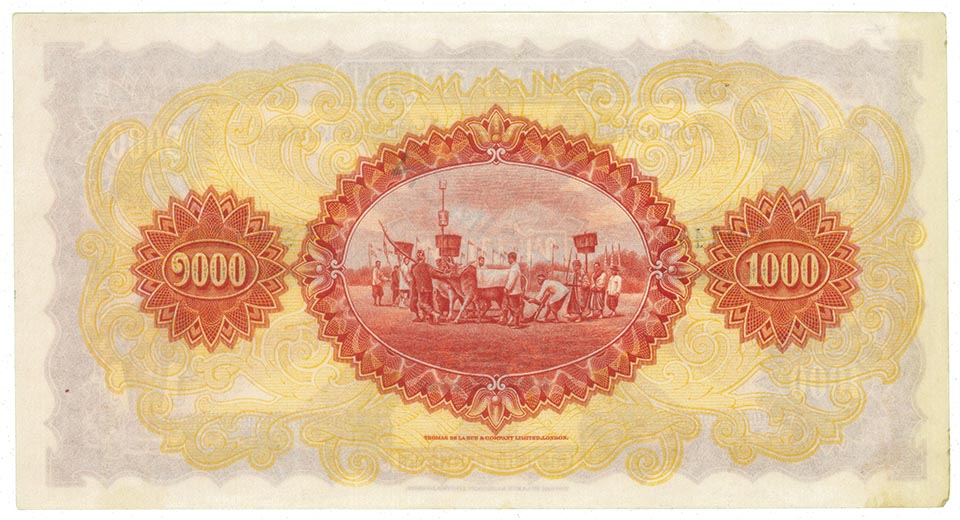
1926 Printing of the 1000 Baht Banknote
On the 27th of March 1926 the Minister of Finance informed TdlR that the printing of the 1000 Baht according to the proof received with the letter of 31st July last, could proceed.
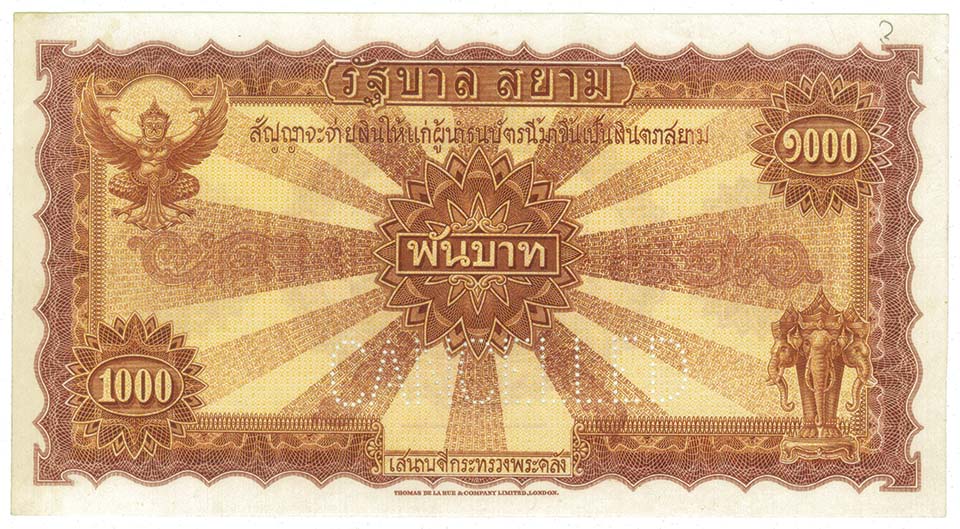
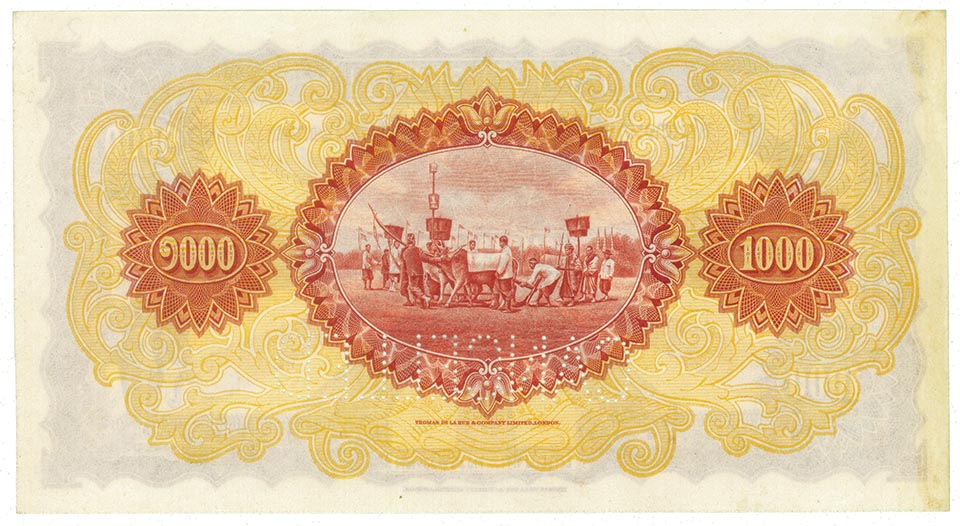
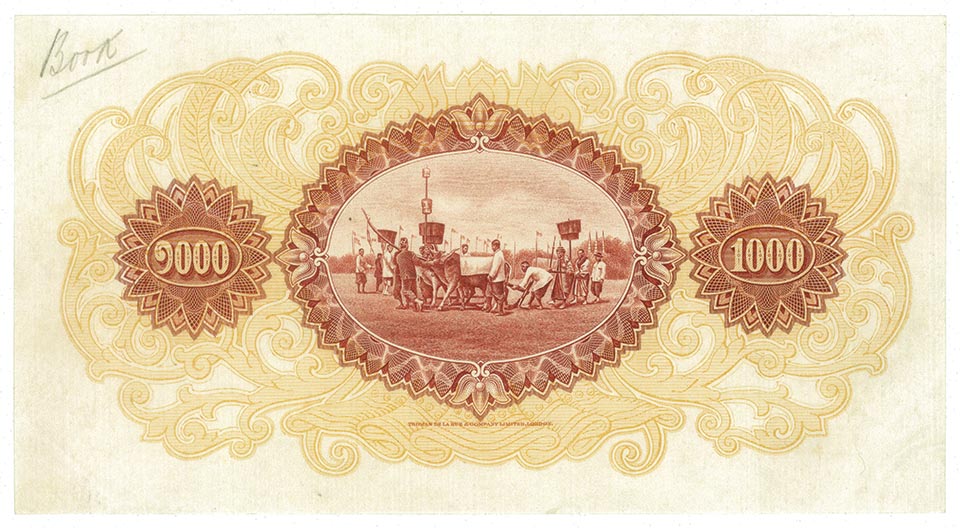
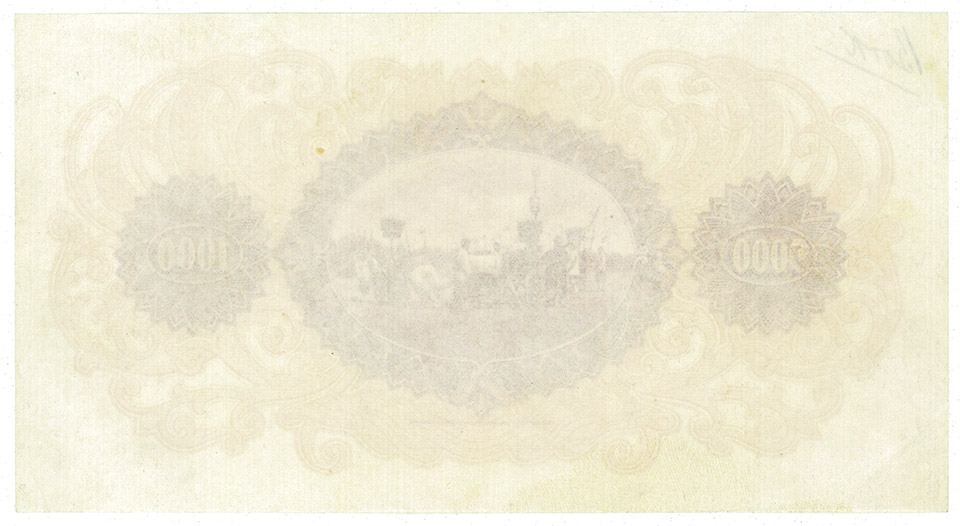
On the 7th June the Minister of Finance requested for a 1000 Baht banknote in colour as he had only received the black proof of the new 1000 Baht design showing the secret marks. On the 31st of July TdlR sent the Minister of Finance in Bangkok a specimen banknote only showing the back. Actually, both sides of the 1000 Baht, had been shipped to the Minister of Finance on the 2nd of July, but were probably delayed in the mail. On the 10th of September the Minister of Finance confirmed having received both.
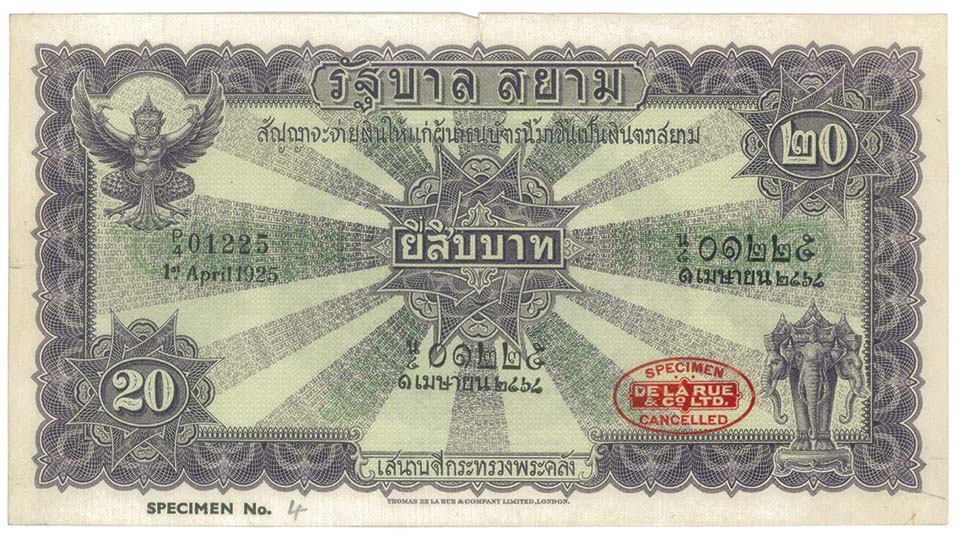
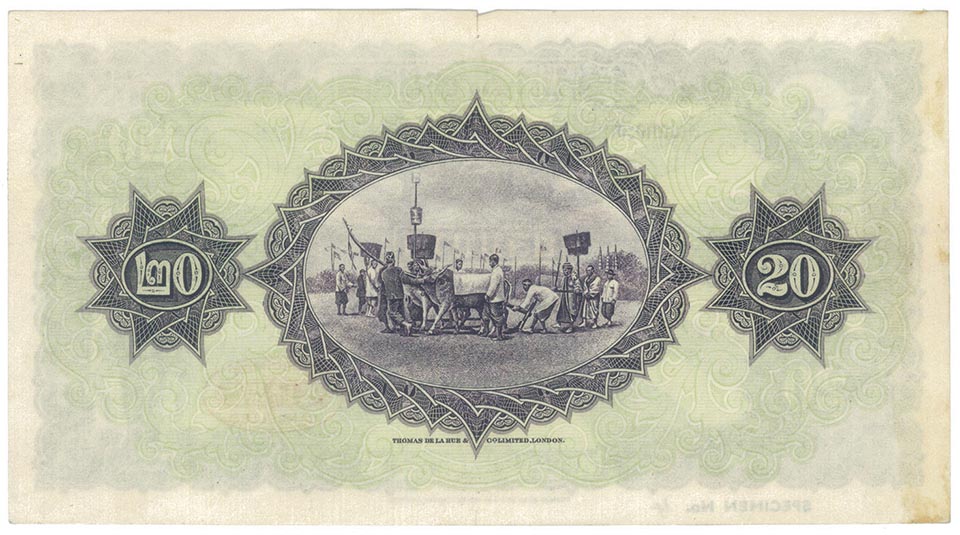
20 Baht 1st April 1925, prefix P/4, number 01225. Oval red TdlR stamp “SPECIMEN DE LA RUE & Co LTD. CANCELLED on lower right. In the lower left margin “SPECIMEN No. 4”. Violet with green floral work in the rays. Very light green under print.
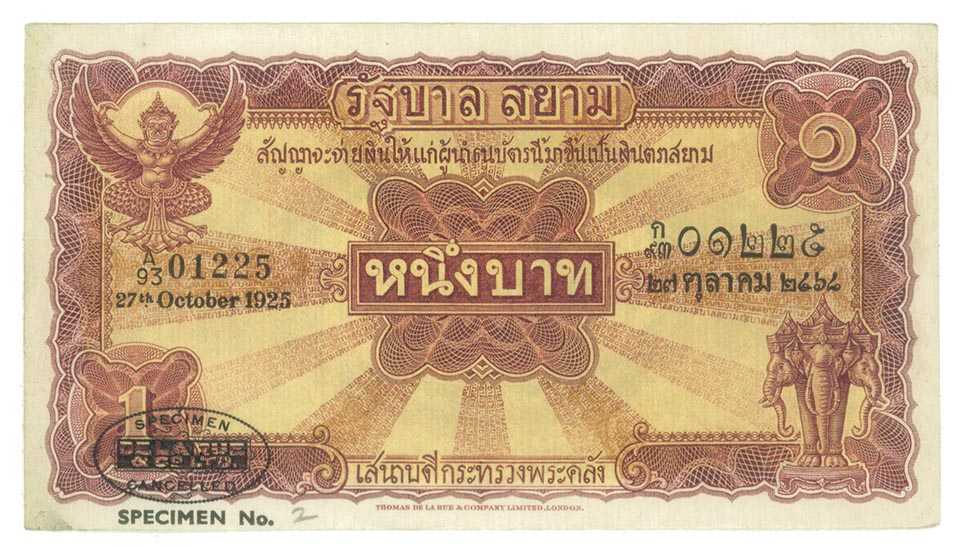
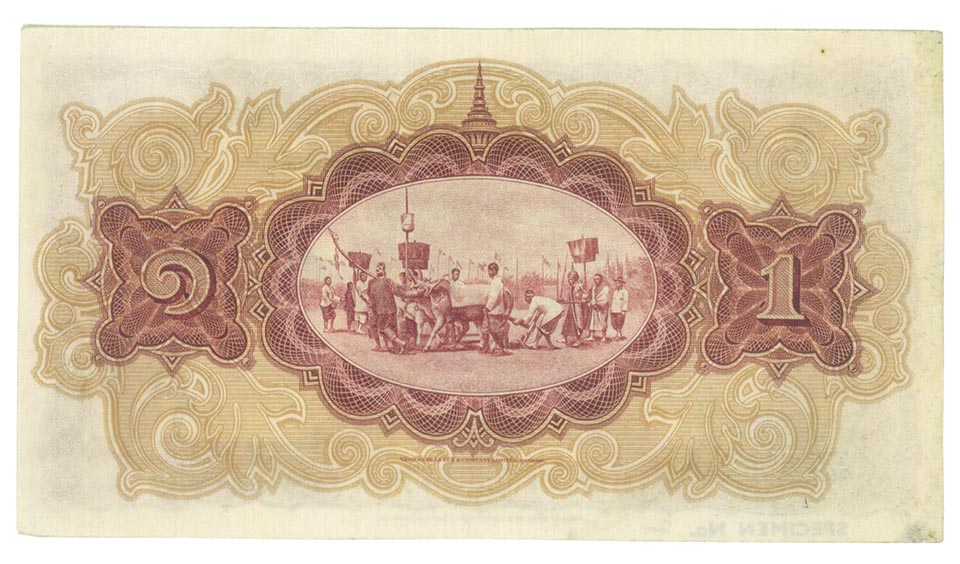
Colour Trial Specimen Banknotes Type I
1 Baht, 27th October 1925, prefix A/93, number 01225. Oval black TdlR stamp “SPECIMEN DE LA RUE & Co LTD. CANCELLED in lover left corner. In the lower left margin “SPECIMEN No. 2”. Brown with green floral work in the rays. Yellow under print.
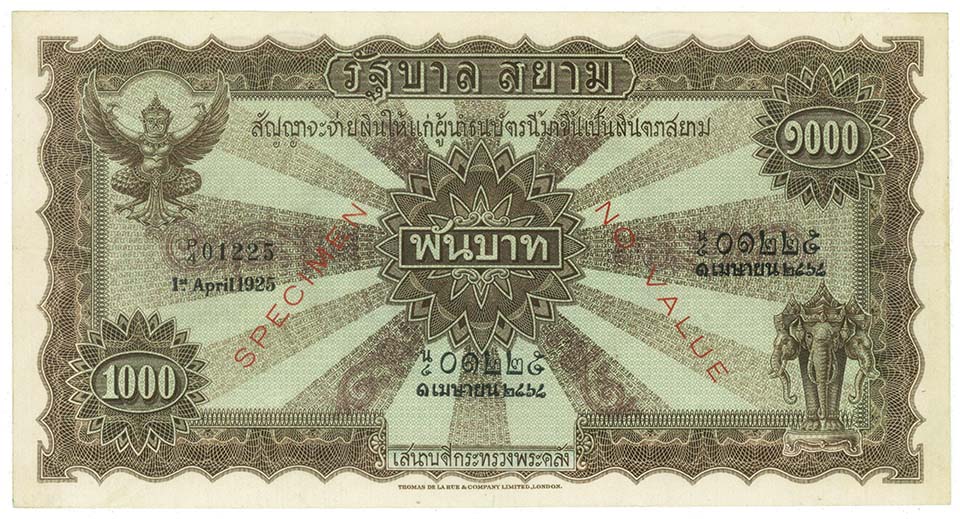
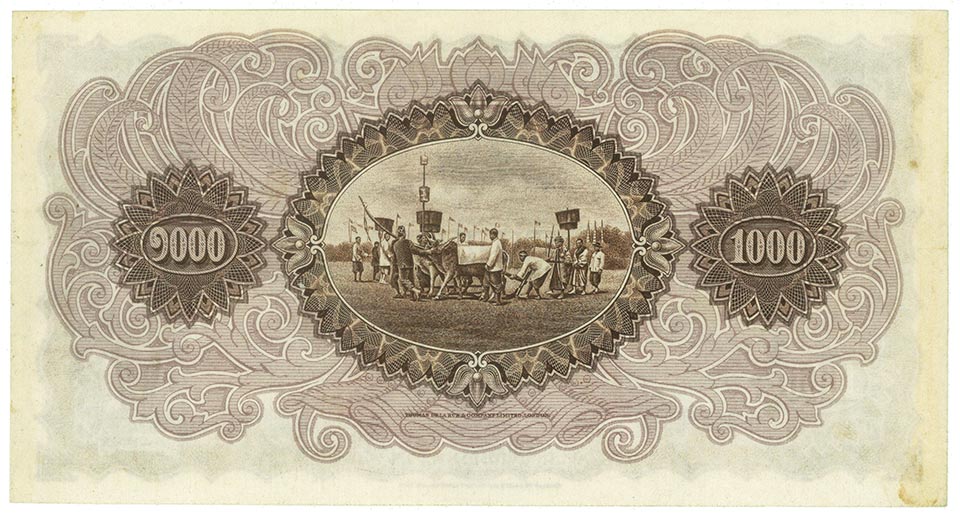
1000 Baht 1st April 1925, prefix P/4, number 01225. Red “SPECIMEN” and “NO VALUE” stamped across. Brown with green under print.
On 21 July 1925, the 1 Baht Second Series, Type I, was put into circulation and announced. The 5-, 10- and 20 Baht was announced on the 18th of February 1926. The 100 Baht was announced on the 19th of November 1928 .The 1000 Baht was also announced on the 15th of July 1928.
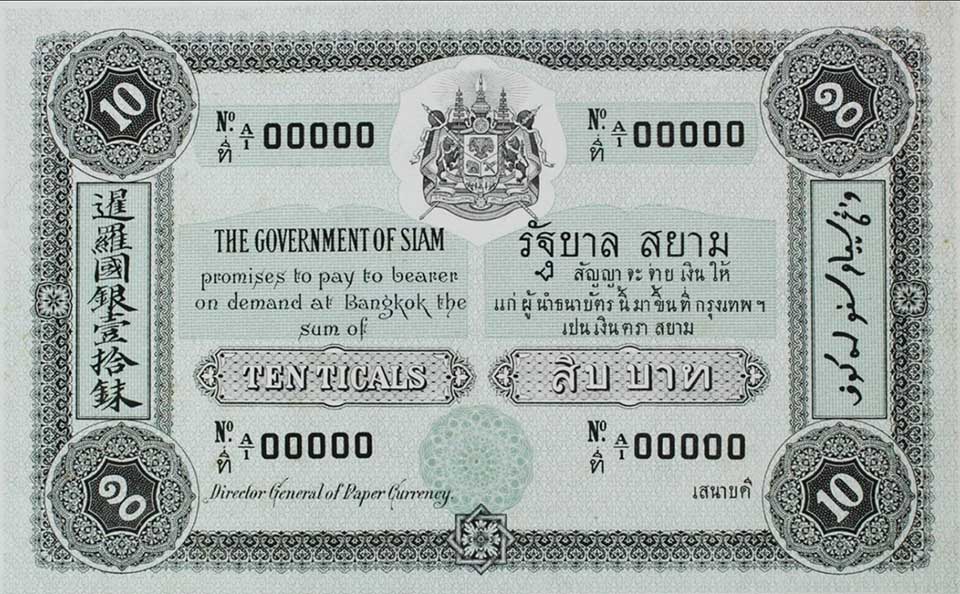
Unknown design 10 Baht banknote sold in Ipswich
Lockdales auction offered a very interesting artwork for a 10 Tical/Baht design in their sale on the 4th of December 2022.
Locdales described the design or artwork as such: “Thailand 10 Baht. The Government of Siam, Bangkok, an unknown design based on the 1902 issue, the design is very similar to the issued note, the main difference being the issued note was brown on yellow underprint, this note is grey on green underprint, the centre text is very different and the 2 lower signature areas are different. Possibly a printer’s design that was never approved for use, or a proof of an unissued design? This came from a gentleman who used to work for Thomas de la Rue so it is believed to be authentic. TdlR print, serial A/1 00000 (Pick 10 for issued note this design is based on) EF”
The auctioneer estimate was 100 GBP – 200 GBP
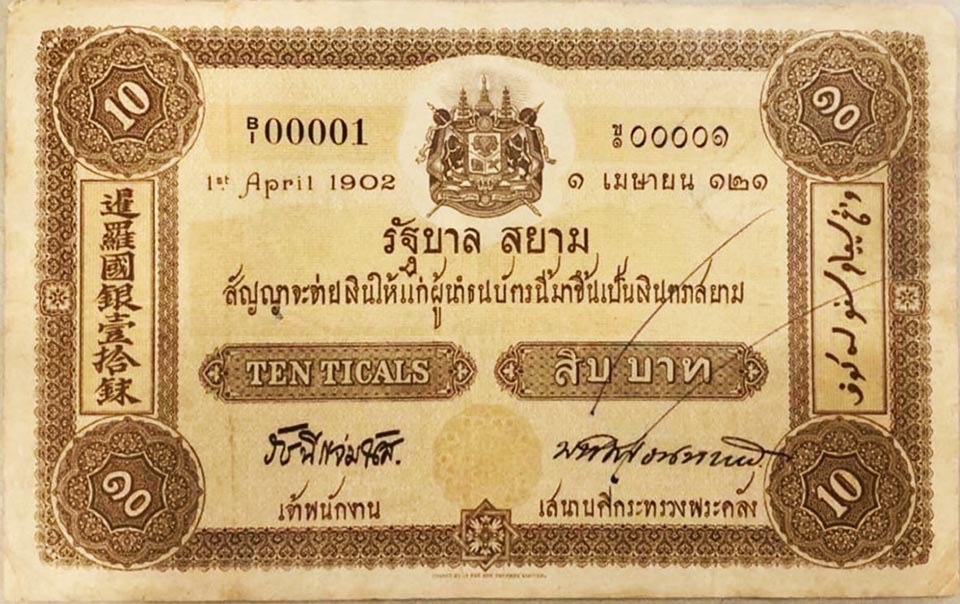
This is the issued 10 TICAL/BAHT dated 1st April 1902. This is the very first produced banknote for circulation with prefix B/1 and number 00001. It is quite different from the design/artwork sold in Locdales auction. According to the book “Centenary of Thai Banknotes: 1902-2012”: In 1900, Mr. Charles James Rivett Carnac, advisor to the Royal Treasure, introduced possibilities on replacement of coins to paper money. His Majesty King Chulalongkorn, Rama V, approved to produce banknotes, and Mr. W. J. F. Williamson, British Officer, Ministry of India, was called to work on this project. Williamson wrote to the Bank of England requesting that Thai banknotes to be printed there. However, the Bank of England declined the request since its service were confined to only India which was then under British rule. Instead, it recommended a British firm, Messrs Thomas de la Rue & Company Limited. The Thai government accepted this and ordered the company to print the first series of banknotes.
The design/artwork sold in the Locdales auction was one of the first designs Thomas de la Rue & Company Limited (TdlR) produced for Thailand, probably in 1901. This design/artwork was not approved, but for collectors and museums it is very attractive.
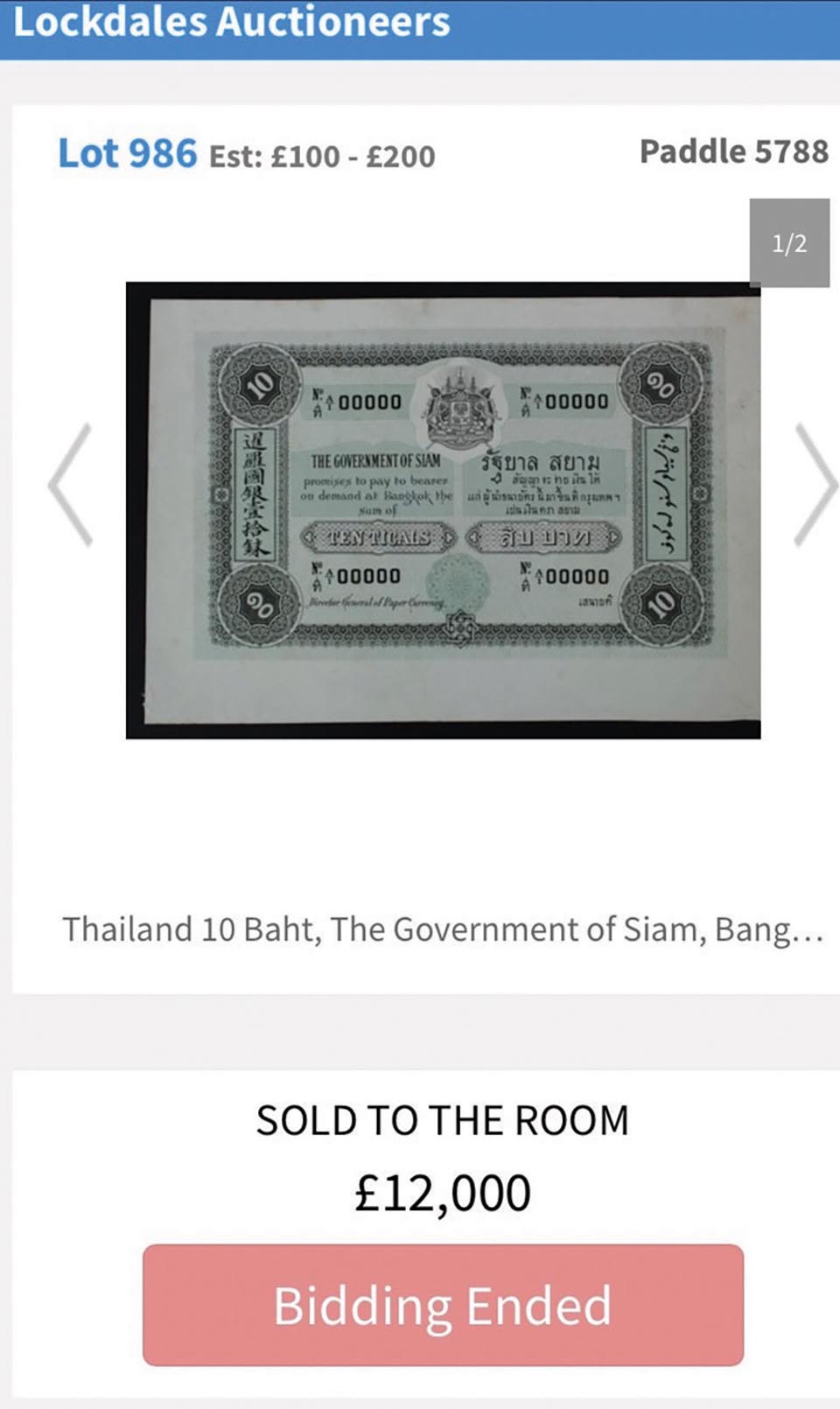
Locdales had estimated the banknote had a value of GBP 100-200 but the opening price was only GBP 60. The bidding started at GBP 180 by an internet bid, followed quickly by an internet bid of GBP 5,000 and a room bid of GBP 10,000. The artwork was finally sold in the room for GBP 12,000 plus commission, a total of GBP 14,808. In THB about 639,000. The estimation of GBP 100-200 was a mistake by the auctioneer as it sold for 60 times more than the highest estimate.
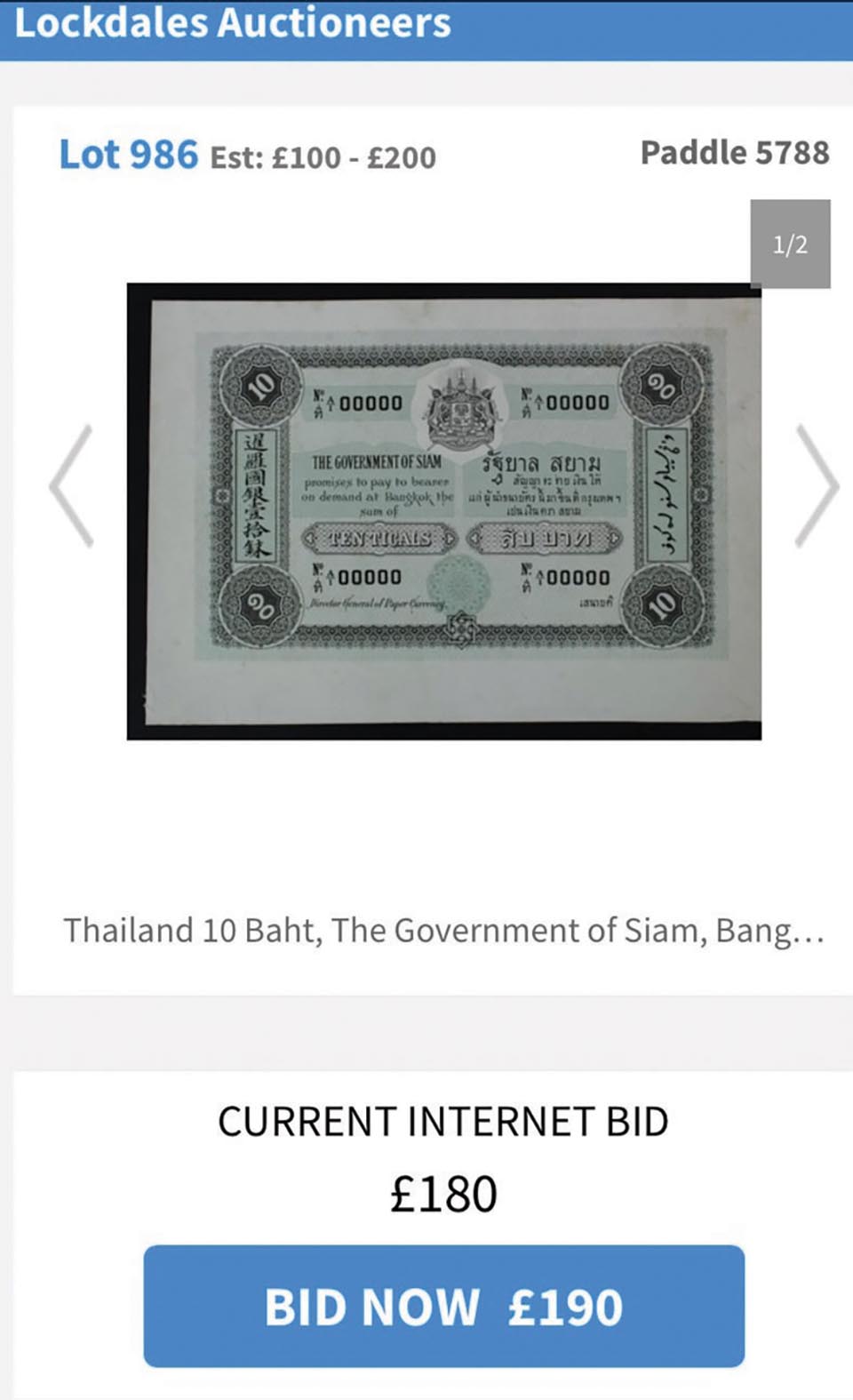
Acknowledgments:
Thank you to Pratheep S. Malhotra for your valuable help.
References:
– The archives of Thomas de la Rue & Company, Limited, London
– 50 Years of the Bank of Thailand 1942-1992.
– Bank of Thailand, “Centenary of Thai Banknotes: 1902-2002”
– Bank of Thailand, BOT Museum’s Masterpieces
– Somchai Saeng-ngern, “Thai Banknotes Catalogue, Complete and Updated Edition”
– Illustrations of banknotes from Jan Olav Aamlid collection
Copyright © 2022 All rights reserved by Jan Olav Aamlid – Member IAPN and IBNS LM-025
 |
 |
 |



